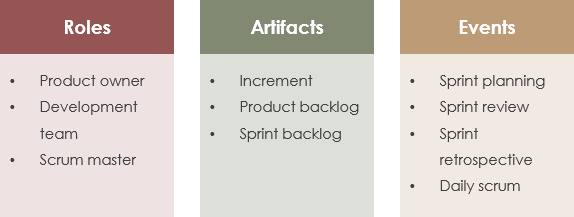The Scrum framework consists of Scrum teams and their associated roles, events, artifacts, and rules, with each component within the framework serving as a specific purpose and is essential to Scrum’s success and usage.


Best Scrum Software Every Project Needs
A powerful scrum software that supports scrum project management. It features scrum tools like user story map, product backlog management, sprint backlog management, task management, daily scrum meeting, sprint planning tool, sprint review tool, sprint retrospective tool, burndown, impediment, stakeholder and team management.
Scrum specifies three major roles that play a part in the Scrum Team: Product Owner, Scrum Master, and Development team member. Besides these roles, you should also expect to have Stakeholders such as Business Analysts in larger organization. The Scrum framework requires four roles:
These individuals share different tasks and responsibilities related to the delivery of the product. Scrum describes this as a self-organizing and cross-functional team.
But who attends what event in scrum? Detailed below are the five events:
Scrum artifacts: Scrum’s artifacts represent work or value to provide transparency and opportunities for inspection and adaptation. Artifacts defined by Scrum are specifically designed to maximize transparency of key information so that everybody has the same understanding of the artifact.
Increment: The sum of all the Product Backlog items completed during a Sprint and the value of the increments of all previous Sprints.
Product Backlog: An ordered list of everything that might be needed in the product which is the single source of requirements for any changes to be made to the product. The Product Owner is responsible for the Product Backlog, including its content, availability, and ordering.
Sprint Backlog: The set of Product Backlog items selected for the Sprint, plus a plan for delivering the product increment and realizing the Sprint Goal.
Product Backlog Refinement: Ongoing Product Backlog Refinement is normally taken place within each Sprint to refine items to be ready for future Sprints.
As mentioned above, the Scrum framework requires three Scrum roles and four main events – but who attends what event in scrum, they are described in the following table:
| Event | Event Owner | Product Owner | Scrum Master | Developer | Other |
|---|---|---|---|---|---|
| Sprint Planning Part I | Product Owner | Y | Y | Y | N |
| Sprint Planning II | Dev | Optional | Y | Y | N |
| Daily Meeting | Dev | N | Optional | Y | N |
| Sprint Review | Product Owner | Y | Y | Y | Y |
| Sprint Retrospective | Scrum Master | Y | Y | Y | N |
| Product Retrospective | Product Owner | Y | Y | Y | N |
Note That:
In Scrum there is no formal event that covers the refinement of the product backlog. Instead, the Scrum Guide states that the “Scrum Team decides how and when refinement is done” and that “refinement usually consumes no more than 10% of the capacity of the Development Team.”
| About Visual Paradigm |
 Visual Paradigm help organizations stay competitive and responsive to change faster and better in today’s fast changing environment. Our award-winning products are trusted by over 320,000 users in companies ranging from small business, consultants, to blue chip organizations, universities and government units across the globe. It enables organizations to improve business and IT agility and foster innovation through popular open standards and process frameworks.Visual Paradigm, a killer Agile feature in 2018, introduced Scrum Process Canvas for automating the way a Scrum team to create, manage and deploy software application that empowers the team to continuously improve their performance at unprecedented speed and scale. Visual Paradigm help organizations stay competitive and responsive to change faster and better in today’s fast changing environment. Our award-winning products are trusted by over 320,000 users in companies ranging from small business, consultants, to blue chip organizations, universities and government units across the globe. It enables organizations to improve business and IT agility and foster innovation through popular open standards and process frameworks.Visual Paradigm, a killer Agile feature in 2018, introduced Scrum Process Canvas for automating the way a Scrum team to create, manage and deploy software application that empowers the team to continuously improve their performance at unprecedented speed and scale.
Manage the Entire Scrum Process in One Page
|